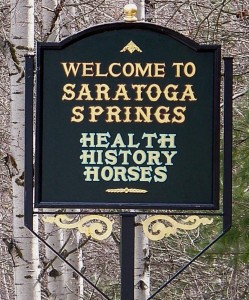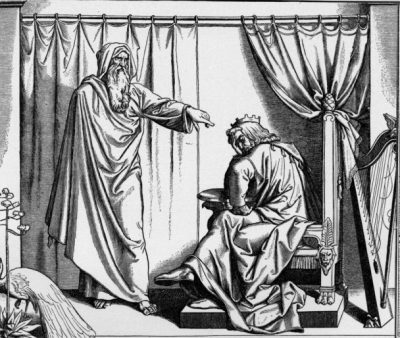
Once upon a time many years ago, there was no tourism in America. And then there was. And the place where tourism began was here in New York State especially along the Hudson Valley.
The tourist explosion combined the artistic explosion generated by people like Irving, Cooper, and Cole along with technological developments like the steamship all New York State developments…and peace with England helped too!
Saratoga helped create this tourist boom.
For a brief moment in the American Revolution, Saratoga became the largest “city” in what was about to become the United States of America. The huge armies and their followers that faced off against each other in the middle of nowhere, made this wilderness locale the site of perhaps the most important battle in the 18th century: the showdown between the Americans and the British that transformed the conflict in a global war when France decided to join.
It also meant that many people suddenly became aware that there were springs in the Saratoga area, mineral springs that naturally were believed to have healing powers. Mohawk Valley’s Sir William Johnson paid a healing visit to the springs in 1771 and gained a legendary cure of his war wounds. That brought tourists once there was peace in their time. The trickle in the late 18th century grew in the 19th century to places called spas, especially to Ballston where the annual meeting of APHNY will be held in 2014. Baths, bathhouses, and hotels meant building the tourist infrastructure on land that the infrastructure by steamship, coach, and rail would support. Such travels at first were restricted to the well-to-do who could afford the expense and had the leisure time, another new phenomena, to partake of such excursions. There were no weekend jaunts, they were like going to the Catskills for the summer more than a century later.
Over the years, there have been several IHARE Teacherhostels/ Historyhostels in Saratoga focusing on the turning point in the American Revolution. As it turns out, visiting the battleground wasn’t a one-way street. It seems that a cannon from the battle decided to see the country and ended up in Tuscaloosa, Alabama. So here we may have the first instance of a upstate New Yorker retiring to the South to escape the winter. Notice of the sojourn piqued the interest of Natural Park Service ranger Joe Craig (listed as “Joseph” for some strange reason in the newspaper; we never called him “Joseph” in our programs!) And eventually the cannon was returned to its rightful place where once again tourists can gaze on this contributor to American independence.
During our programs, we often met in the Saratoga Springs visitor center for some talks about the war before going to the various historic sites related to the battle and taking a cruise on the canal.
Just outside the visitor center is a historic marker that we never paid much attention to since it did not directly relate to our purpose in being there. It recalled a former slave who had been kidnapped as a free person practically from that spot on Congress and Broadway. That kidnapping initiated a successful 12-year effort to free him leading to the publication of a book in 1853 entitled Twelve Years a Slave: Narrative of Solomon Northrup, a Citizen of New-York, Kidnapped in Washington City in 1841, and Rescued in 1853, From a Cotton Plantation Near the Red River, in Louisiana. Little did we know it would become a movie. Looks like the cannon is the only one with a north-south story to tell. Saratoga now celebrates the annual Solomon Northup Day Celebration of Freedom.
The layers of history didn’t cease with the revelation of the wisdom of Solomon. Following the end of Prohibition and originating with the efforts of Governor Franklin Delano Roosevelt, New York build a huge still-standing spa as a state park. There also was a racecourse nearby where a horse named Seabiscuit sometimes ran. And he won too leading to his becoming not simply a leading horse but one which transcended the sport. He became the subject of a book and a movie too although unlike the Northrup book, he didn’t write it (and he didn’t dictate it either since he was not a talking horse!).
On a more intimate and less grandiose scale, Caffè Lena added another layer to Saratoga’s history. This legendary cafe was called “folk music heaven” in a recent article in the New York Times. The cafe which opened in 1960 was honored with a book Caffè Lena: Inside America’s Legendary Folk Music Coffeehouse. This daughter of American immigrants contributed to the American Dream by hosting the who’s who of what was becoming the folk music scene in the country, and besides the book, there also is a CD box set of the music played there.
So Saratoga is boffo at the box office and still going strong. This excavation of a single area was meant to illustrate the rich history of the region, to show how much more there is than simply a visit to the battlefield or the racetrack or a spa. Imagine putting all the pieces together for an immersion experience into the history of America through the lens of a single place. Just because the Governor has given up on the Path through History, doesn’t mean I have.
Readers interested in learning more can go to:
Richard Gasson, The Birth of American Tourism: New York, the Hudson valley, and American Culture, 1790-1830 (Amherst: University of Massachusetts Press, 2008).
Field Horne, “Saratoga Springs: Evolution of a Resort,” New York Archives 2:1 2002:21-23.
Ed Hotaling, “Seabiscuit’s Saratoga,” New York Archives 3:1 2003:18-21.





The “Battle”: this seems to continue the confusion as to the Rev War battle, which was called “Saratoga” but fought several miles away near the Hudson River in todays town of Stillwater. No fighting took place here as far as I can find, BUT I recently heard that todays “Stillwater” was once named Saratoga. Thus leading to the naming confusion.
True / False ??
bob ulrich
The Town of Stillwater was formed in 1791 and the Village was incorporated in 1816. Therefore, officially, no legal entity of Stillwater existed at the time of the battle of Saratoga. Today, of course, these municipalities do exist and the battlefield is located within those jurisdictions.
NO! Saratoga County was formed in 1791, at which time the Town of Stillwater already existed. The Town of Stillwater was created by an act of the New York State Legislature on 7 March 1788. It had previously been a part of the Albany County District of Saratoga, and even earlier was part of the Patent of Saratoga. It might therefore be argued that parts of Stillwater were indeed called “Saratoga” at some early time.
My information comes from the website of the Town of Stillwater. In its history section it does mention the formation of the County of Saratoga in 1791 with the following sentences stating the town was formed in 1791 and the village was chartered in 1816. Perhaps you should contact the town to clarify the matter and perhaps correct its website.
Relying a bit heavily on secondary (or even tertiary) sources, aren’t you?
The Saratoga Battlefield and visitors center has also spawned interest in Revolutionary War figures buried in New York City such as General Horatio Gates and Marinus Willett. I t was as a result of one visitor’s journey to the Battlefield 25 years ago that an effort was recently undertaken by the New York State Daughters of the American Revolution to place a plaqe in New York City’sTrinity Churchyard marking the previously unmarked grave of General Gates, the commanding general at Saratoga. As a result of the 2012 ceremony placing that marker, there is now a wreath laying ceremony every July 4 in Trinity Churchyard commemorating General Gates, Alexander Hamilton and Marinus Willett, and a ceremony in mid -October sponsored by the Sons of the Revolution, the Sons of the American Revolution, the Daughters of the American Revolutin and National Democratic Club, commemorating the anniversary of the American victories at Saratoga and Yorktown.
I’ve always understood the name Saratoga Springs came not just from the mineral waters but to distinguish the place from Saratoga, the site on the Hudson River. William Johnson would probably have arrived from the west or north, but other visitors, like Washington, would have come up the Hudson to Saratoga, then disembarked to travel inland to the springs.
Few small cities are as well studied and as historically rich as Saratoga Springs. In addition to Richard Gassan’s good book, I think my Drinking the Waters: Creating an American Leisure Class at Nineteenth-Century Mineral Springs Resorts (Smithsonian, 2002) covers Saratoga Springs well. And it’s comparative in focus, with similar resorts in Virginia serving as counterpoints. In Western New York places like Lewiston and East Aurora, quaint villages in their own right, say that they are “like Saratoga” in history and ambience. The spa city sets the state’s standard!
Saratoga is a fascinating place indeed. The book “Saratoga: The Place and Its People” published by Abrams in 1988 was launched back in 1946 when I, as a twelve year old with a camera, spent some weeks at the old Grand Union Hotel and the track world. As a grown up photojournalist (armed with Henry Graff’s research insights) I returned for a summer at Saratoga for National Geographic Traveler. That was escalated into a book for Abrams, with a crew of well-informed colleagues doing the essays and myself doing all of the extended captions in the book. All of the old prints and photographs are still in my possession, as well as my photographs. FYI and your feedback.
Thanks for your informative communications.
Legalisms aside, the place-name “Stillwater” [as in “the Still Water” located above the mouth of the Hoosac River’s entrance into the Hudson at Schaghticoke] dates to the early 18th century and clearly pre-dates the Battle. More cogently, Channing’s multi-volume History of the United States [recipient of the Pulitzer Prize in History and the gold standard of multi-volume histories in the early 20th century] referred to the “First and Second Battles of Stillwater” never mantioning Saratoga as commonly used today. The surrender of Burgoyne-in many sources contemporaraneous and later- note that the event took place in “Old Saratoga”, currently the Town of Schuylerville. Any way you cut it, Saratogians pulled the wool over the eyes of later generations who apparently think history s nothing more than bunk- and horse-racing.
The discussion over the name rages on. Bob Ulrich’s initial question about the name of the site of battle led to my response about about the town and village of Stillwater not existing legally in 1777. My information came from the website of the Town. Lynn Calvin took issue with that claim saying the town was incorporated in 1788 which still would place it after the battle. She will be contacting the Stillwater town historian to correct the town’s website.
The result is to leave open what did the locals call the area regardless of legal and political considerations. It certainly seems likely that the people on the ground called the area Stillwater. But what about Burgoyne? In a letter dated October 20, he wrote about his army being “encamped on the heights and in the plain of Saratoga, the enemy being in the neighbourhood of Stillwater.” He mentioned “Dovegot” which sounds a lot like a restaurant in Stillwater where we have eaten on some Teacherhostels/Historyhostels. It seems like both names were in use. It might be interesting to review the correspondence of the generals and the newspaper accounts of the time to ascertain what it was called when it happened. Obviously the name “Saratoga” and not “Saratoga Springs!” prevailed.